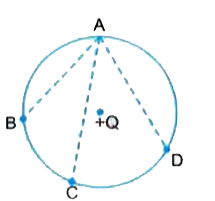In the firgure the charge Q is at the centre of the circle. Work done is maximum when another charge is taken from point P to

K
L
M
N
The correct Answer is:A
Work done in moving a charge from P to L,P to M and P to N is zero.
Topper's Solved these Questions
- ELECTRIC POTENTIAL & CAPACITANCEBook:A2ZChapter:ELECTRIC POTENTIAL & CAPACITANCEExercise:Capacitor
Explore 32 Videos
- ELECTRIC POTENTIAL & CAPACITANCEBook:A2ZChapter:ELECTRIC POTENTIAL & CAPACITANCEExercise:Capacitor With Dielectric
Explore 32 Videos
- ELECTRIC POTENTIAL & CAPACITANCEBook:A2ZChapter:ELECTRIC POTENTIAL & CAPACITANCEExercise:Electric Potential Energy
Explore 22 Videos
- ELECTRIC CHARGE, FIELD & FLUXBook:A2ZChapter:ELECTRIC CHARGE, FIELD & FLUXExercise:Section D - Chapter End Test
Explore 29 Videos
- ELECTROMAGNETIC INDUCTIONBook:A2ZChapter:ELECTROMAGNETIC INDUCTIONExercise:Section D - Chapter End Test
Explore 30 Videos
Similar Questions
In the electric field of a point charge (+q) , placed at the centre of a circle , a certain test charge is carried from point A to B, C,D and E Least amount of work is done along the path

View Solutiona. A circle is drawn with center as a charge +q. What is the work done in moving a charge +q from B to C along the circumferebce of the circle ?
B In the above question, if the charge +q is first taken from B to A and then from A to C, on which path is the magnitude of work greater ?
 .
.
View Solution
Knowledge Check
In the electric field of a point charge Q placed at the centre of a circle, as shown in fingure, a certain test charge q0 is carried from point A to B, C B and D. Then the work done
 Ais least along the path AB.Bis least along the path AC.Cis same along all the three paths AB, AC as well as AD and has a finite value.Dis zero for all the three paths.
Ais least along the path AB.Bis least along the path AC.Cis same along all the three paths AB, AC as well as AD and has a finite value.Dis zero for all the three paths.A,B,C are three points as a circle of radius 1cm.These points form the corners an equilateral triangle .A charge 2C is placed at the centre of circle .The work done in carrying a charge of 0.1μc form A to B is
AzeroB18×1011JC1.8×1011JD54×1011JAs per this diagram a point charge +q is placed at the origin O. Work done in taking another point charge −Q from the point A(0,a) to another point B(a,0) along the staight path AB is:
 A(−qQ4πε01a2)√2aBzeroC(qQ4πε01a2)1√2D(qQ4πε01a2)1√2a
A(−qQ4πε01a2)√2aBzeroC(qQ4πε01a2)1√2D(qQ4πε01a2)1√2a
As per this diagram a point charge +q is placed at the origin O. Work done in taking another point charge −Q from the point A(0,a) to another point B(a,0) along the staight path AB is:

View SolutionA dipole of 2μC charges each, consists of the positive charge at the point P (1, -1) and the negative charge is placed at the point Q(-1, 1). The work done in displacing a charge of +1μC from point A(−3,−3) to B (4, 4) is
View SolutionWhen 1 J of work is done in moving a charge of 1 C from one point A
View SolutionA point positive charge of Q' units is moved round another point positive charge of Q units in circular path. If the radius of the circle r is the work done on the charge Q' in making one complete revolution i-
View SolutionThere is 10 units of charge at the centre of a circle of radius 10m. The work done in moving 1 unit of charge around the circle once is
View Solution

